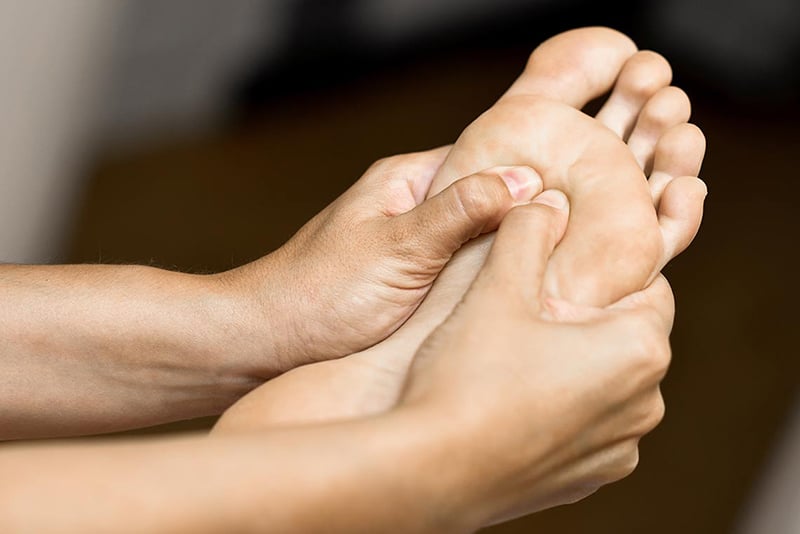
Morton's neuroma: definition, symptoms, diagnosis and treatment
For Morton’s Neuroma we mean a suffering of the III common digital nerve, an exclusively sensory nerve that innervates the 3rd and 4th toe caused by chronic microtraumas at the point of transition between the heads of the III and IV metatarsals
Less frequently, neuromas exist in the other intermetatarsal spaces.
Morton’s neuroma: where does it come from?
Morton’s Neuroma develops following compressive microtraumas which, over time, lead to the formation of fibrous tissue within the nerve and therefore increase its size.
Passing between the heads of the metatarsals, the thickened nerve is compressed and hence the symptoms.
The causes of these microtraumas can be found in the conformation of the foot, hallux valgus, flat foot or hollow foot, they are all conditions that are associated with a forefoot support problem.
It happens to hear that Morton’s Neuroma is a disease connected to the footwear worn by patients, but it is an erroneous belief, as shoes with high heels or particularly narrow toes are not the main cause, however, they can aggravate the symptoms.
What are the symptoms of Morton’s Neuroma?
But how does Morton’s Neuroma differ from other metatarsalgias? We immediately recognize it from a stabbing pain, similar to an electric shock, associated above all with foot support, which radiates towards the toes and from which the patient often finds relief only by taking off his shoes.
The pain, however, is not constant, but alternates with asymptomatic moments (even days) and can also appear associated with tingling, or with the foot at rest, even while sleeping.
Treatment options, from conservative therapy to surgery
The therapies for Morton’s Neuroma can be conservative at first and, therefore, do not require the use of surgery.
We are talking, for example, of cortisone infiltrations, or of the use of orthotics that improve foot support and relieve compression on the nerve.
However, this approach does not always lead to definitive results, since the pain often tends to recur and it is not recommended to repeat cortisone infiltrations for too long.
If the dimensions of the neuroma exceed 4-5 mm, surgical treatment is recommended.
The surgery that is preferred is the one that makes use of minimally invasive techniques, therefore by means of a small longitudinal skin incision on the back of the foot (about 2 cm), the surgeon accesses the intermetatarsal area to isolate and remove the Neuroma.
It should be noted, from this point of view, that the removal of the nerve does not cause problems in walking and in the functionality of the toes, only a small numbness on the inner face of the toes.
Furthermore, the recovery of the patient is relatively fast and involves the use of a shoe in talo for two weeks, no crutches or physiotherapy are needed.
Read Also
Emergency Live Even More…Live: Download The New Free App Of Your Newspaper For IOS And Android
Morton’s Neuroma: What It Is And What The Symptoms Are
Foot Arthrosis: Symptoms, Causes And Treatment
Foot Deformities: Metatarsus Adductus Or Metatarsus Varus
Pain In The Sole Of The Foot: It Could Be Metatarsalgia
Orthopaedics: What Is Hammer Toe?
Hollow Foot: What It Is And How To Recognise It
Occupational (And Non-Occupational) Diseases: Shock Waves For The Treatment Of Plantar Fasciitis
Flat Feet In Children: How To Recognise Them And What To Do About It
Swollen Feet, A Trivial Symptom? No, And Here’s What Serious Diseases They May Be Associated With
Diabetic Foot: Symptoms, Treatment And Prevention
Claw Fingers (Hammer Fingers): What Are They?
Orthopaedics: What Is Hammer Toe?
Hand Disorders: 10 Exercises And Remedies For Claw Fingers
Arthrosis: What It Is And How To Treat It
Juvenile Idiopathic Arthritis: Study Of Oral Therapy With Tofacitinib By Gaslini Of Genoa
Rheumatic Diseases: Arthritis And Arthrosis, What Are The Differences?
Rheumatoid Arthritis: Symptoms, Diagnosis And Treatment
Joint Pain: Rheumatoid Arthritis Or Arthrosis?
Arthrosis: What It Is And How To Treat It
Working Shoes Comparison For Ambulance Professionals And EMS Workers


